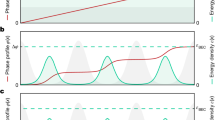Abstract
In a comment on our article “Theory of Thomson scattering in inhomogeneous media”, V. V. Belyi asserts that there is an inconsistency in our method of applying gradient effects via the dielectric superposition principle, in violation of the fluctuation-dissipation theorem; and that his Klimontovich-Langevin formulation would be more appropriate to our application. While we agree that a generalization, along the lines of Belyi’s work, would be required for strongly coupled systems, for the weakly coupled systems which we considered, these corrections are not necessary and our approach is still appropriate.
Replying to: V. Belyi, Sci. Rep. 8 (2018); https://doi.org/10.1038/s41598-018-25319-6.
Similar content being viewed by others
Introduction
We thank Belyi for his comment on our manuscript. First, we would like to note that both our work and Belyi’s work find that strong modifications of the equilibrium structure factors are possible in inhomogeneous and relaxing media1,2. We agree that Belyi’s treatment is more general than ours, and indeed gradient corrections in both the densities and the fields must be included, in general. Such a treatment is particularly required for strongly coupled plasmas. However, it was never our intention to describe systems with strong interactions in the electron component. As we explicitly stated, Eq. (2) of our paper is derived in the limit of the random phase approximation (RPA) applicable for weakly interacting electrons, as they occur in many experiments1. This treatment is equivalent to the dielectric superposition principle, as was shown by Ichimaru3. In the RPA limit, Eq. (2) of our paper is the correct connection between the dielectric response and the dynamic electron structure factor. In the same limit, gradient corrections only apply to the screening dielectric function and not to the ideal structure factor - which is clearly unaffected by gradients. This behaviour is related to the fact that gradients generate nonlocal effects in the screening electric fields (via the nonlocal Poisson equation), whereas there is no such inter-particle field to carry nonlocal effects in the ideal gas3. For that reason, the gradient expansion is only acting on the dielectric function and not on the ideal dynamic structure factor. Of course, the summation of spatial domains with different conditions must still be done. Therefore, Eqs (2) and (4) are consistent in describing the effects of gradient corrections to the dynamic structure factor for weakly coupled plasmas, where the RPA is valid, with small perturbations.
In contrast to the considered case of weakly coupled plasmas, all contributions to the total structure factor should be subject to the gradient expansion for systems with moderate or strong interactions. In this case, the approximation of Eq. (2) becomes invalid and one needs to apply a more general treatment, e.g., as presented by Belyi2. Of course, these gradient effects, and therefore the differences between our theories, are only important for scattering parameters \(\alpha ={k}_{D}/k > 1\), and both theories agree in the limit α <<1, where the scattering is dominated by single particle scattering and the additional correction terms due to the plasma gradients vanish.
In conclusion, we thank Belyi for pointing out a valuable extension to our work, that goes beyond the RPA limit and can describe a larger class of situations. We hope that both of our results will stimulate further studies on this topic.
References
Kozlowski, P. M. et al. Theory of Thomson scattering in inhomogeneous media. Sci. Rep. 6 (2016).
Belyi, V. V. Thomson scattering in inhomogeneous plasmas: The Role of the Fluctuation-Dissipation Theorem. Sci. Rep (2018).
Ichimaru, S. In Basic Principles of Plasma Physics, Ch. 7 Fluctuations, 251–255 Addison-Wesley (1973).
Author information
Authors and Affiliations
Contributions
P.M.K., D.O.G. and G.G. wrote the main manuscript text. All authors revised and reviewed the manuscript.
Corresponding author
Ethics declarations
Competing Interests
The authors declare no competing interests.
Additional information
Publisher's note: Springer Nature remains neutral with regard to jurisdictional claims in published maps and institutional affiliations.
Rights and permissions
Open Access This article is licensed under a Creative Commons Attribution 4.0 International License, which permits use, sharing, adaptation, distribution and reproduction in any medium or format, as long as you give appropriate credit to the original author(s) and the source, provide a link to the Creative Commons license, and indicate if changes were made. The images or other third party material in this article are included in the article’s Creative Commons license, unless indicated otherwise in a credit line to the material. If material is not included in the article’s Creative Commons license and your intended use is not permitted by statutory regulation or exceeds the permitted use, you will need to obtain permission directly from the copyright holder. To view a copy of this license, visit http://creativecommons.org/licenses/by/4.0/.
About this article
Cite this article
Kozlowski, P.M., Gericke, D.O., Regan, S.P. et al. Reply to ‘Thomson scattering in inhomogeneous plasmas: The Role of the Fluctuation-Dissipation Theorem’. Sci Rep 8, 7947 (2018). https://doi.org/10.1038/s41598-018-25322-x
Received:
Accepted:
Published:
DOI: https://doi.org/10.1038/s41598-018-25322-x
Comments
By submitting a comment you agree to abide by our Terms and Community Guidelines. If you find something abusive or that does not comply with our terms or guidelines please flag it as inappropriate.



